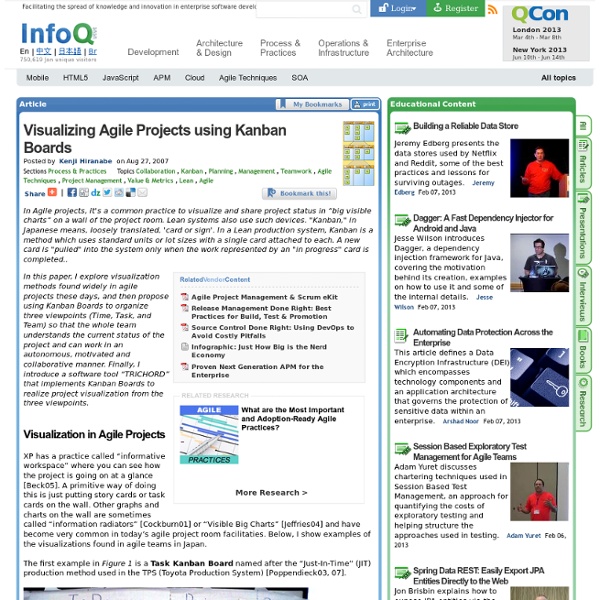LFC
Le kanban est un terme japonais signifiant « étiquette », c'est une simple fiche que l'on fixe sur les bacs ou les conteneurs de pièces sur une ligne de production, d'assemblage ou dans une zone de stockage. Mais avant tout, le kanban est une méthode de travail qui a pour but de définir les modalités de mise en route d'une production en flux tirés. C'est un système d'information qui fonctionne entre deux postes de travail et limite la production du poste amont aux besoins exacts du poste aval. Ce sont donc les commandes clients qui déclenchent automatiquement la fabrication par remontée des ordres depuis la sortie des produits. Ce type de fonctionnement permet d'améliorer la productivité grâce à: Une précision de production Une flexibilité Une consommation réelle Une production par petits lots Des petits stocks Un management visuel Une meilleure communication Programme de formation
Agile Methods Specialist Group
The Agile Methods Specialist Group will focus on the implementation and promotion of Agile methods covering all the disciplines in the lifecycle of a project. The Specialist Group was launched on 24 January 2012, where delegates elected the Group's committee and took part in an engaging workshop on 'What is the current status of Agile?' and 'Where will Agile be in 2020?' Keep in Touch with us Listed below are ways to keep in touch with what's happening with the group. If you are a BCS Member you can register your interest to join the Group once it has been inaugurated by selecting 'Agile Methods' from this list (BCS Member login required).If you are a non-BCS Member, join today to gain access to the group.You can email the group at agile.sg@bcs.orgFollow the group on twitter - @BCS_AgileJoin our linkedin groupJoin our Agile Methods SG Facebook group
L'Extreme Programming
Depuis les débuts de l'informatique commerciale dans les années '60, plusieurs méthodologies de développement de logiciel ont vu le jour. Le modèle en cascade et ses dérivés ont connu un grand succès, mais leur lourdeur et rigidité sont de sérieux handicaps. Extreme Programming propose de remplacer certaines notions acquises par des idées révolutionnaires, et de rendre le développement de logiciel efficace et agile. I-A. La petite histoire d'une grande industrie▲ L'histoire du développement de logiciels est intimement liée à l'histoire de l'industrie informatique. I-B. Le transistor a été inventé en 1948, et l'ordinateur sous sa forme actuelle existe depuis les années '50. Les années '70 ont vu l'apparition des langages C, Pascal et Basic, de Unix, du circuit intégré, de Apple, Intel et Microsoft, et des premiers micro-ordinateurs. I-C. Des méthodologies de développement sont apparues à différents moments durant la révolution informatique. I-D. II-A. II-B. III-A. III-B. III-C. III-D.
QCon London 2013 Conference
Agile software development
Agile software development is a set of principles for software development in which requirements and solutions evolve through collaboration between self-organizing,[1] cross-functional teams. It promotes adaptive planning, evolutionary development, early delivery, and continuous improvement, and it encourages rapid and flexible response to change.[2] Agile itself has never defined any specific methods to achieve this, but many have grown up as a result and have been recognized as being 'Agile'. The Manifesto for Agile Software Development,[3] also known as the Agile Manifesto, was first proclaimed in 2001, after "agile methodology" was originally introduced in the late 1980s and early 1990s. The manifesto came out of the DSDM Consortium in 1994, although its roots go back to the mid 1980s at DuPont and texts by James Martin[4] and James Kerr et al.[5] History[edit] Incremental software development methods trace back to 1957.[6] In 1974, E. The Agile Manifesto[edit] Agile principles[edit]
Kanban et Scrum - tirer le meilleur des deux
Ce livre fait partie de la collection de livres InfoQ "Enterprise Software Development". Avec ce livre, vous apprendrez ce qu'est Kanban, ses forces et ses limites, et quand l'utiliser. Vous apprendrez également comment Kanban peut améliorer Scrum, ou tout autre outil que vous utilisez, et à quel moment c'est possible. Henrik montre clairement que le plus important n'est pas l'outil avec lequel on commence, mais la façon dont on améliore constamment son utilisation et comment on développe progressivement son ensemble d'outils. Mary Poppendieck, auteur de plusieurs livres de référence sur le Lean Software Development. Je suis très heureux qu'Henrik Kniberg et Mattias Skarin aient émergé comme des leaders dans ce domaine. David Anderson, fondateur de l'Agile Project Leadership Network, membre fondateur de Feature Driven Development (FDD), et auteur de livres sur l'agilité. 7 commentaires Henrik Kniberg, Mattias Skarin Lire l'article. Article lu 7368 fois.
Principles behind the Agile Manifesto
We follow these principles: Our highest priority is to satisfy the customer through early and continuous delivery of valuable software. Welcome changing requirements, even late in development. Deliver working software frequently, from a couple of weeks to a couple of months, with a preference to the shorter timescale. Business people and developers must work together daily throughout the project. Build projects around motivated individuals. The most efficient and effective method of conveying information to and within a development team is face-to-face conversation. Working software is the primary measure of progress. Agile processes promote sustainable development. Continuous attention to technical excellence and good design enhances agility. Simplicity--the art of maximizing the amount of work not done--is essential. The best architectures, requirements, and designs emerge from self-organizing teams. Return to Manifesto
Manifesto for Agile Software Development



